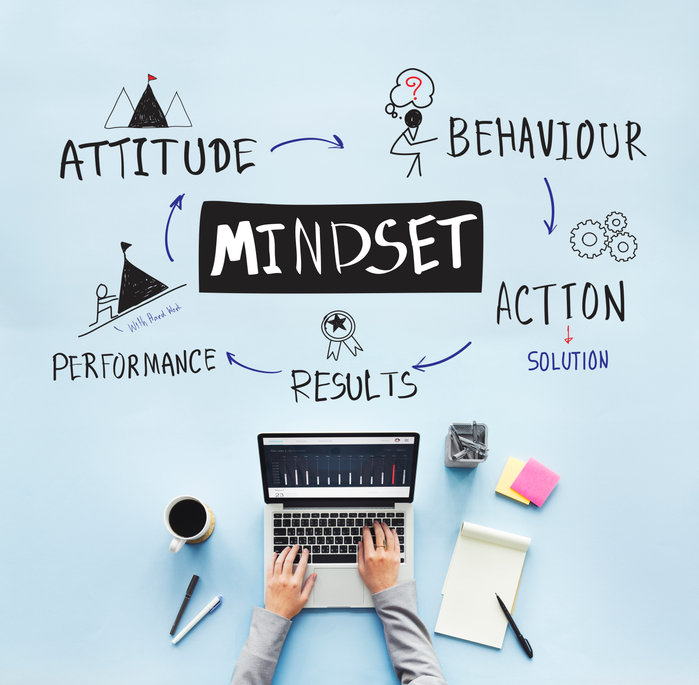
I often talk about the importance of “strategic thinking” as an essential skill of any modern marketer. The ability to think strategically comes from your thought process, which I call “mindset.”
I like this definition from Sources of Insights: “Your mindset is your collection of thoughts and beliefs that shape your thought habits. And your thought habits affect how you think, what you feel, and what you do. Your mindset impacts how you make sense of the world and how you make sense of yourself.”
Yes, your mindset is a BIG deal.
It impacts how you approach marketing, career development, and management communications. Let me show you how they are related.
Your mindset guides your marketing efforts “Thoughts are behaviors we haven’t learned to observe yet.” – B.F. Skinner
Your marketing mindset should focus on:
- Customer Understanding
- Strategic Plans
- Technologies and Executions
Understand Your Customer: Customer-centric mindset
It’s all about an ability to constantly think from customers’ perspectives. Most of us (myself included) tend to think about what “we” want to say and how “we” want to say it. This mindset comes from what we need to say to market our products and services. It really needs to turn it around, though, and instead focus on: what “my customers” want to hear and how “my customers” want us to help them.
It’s not about us; it’s about them.
That mindset will constantly motivate you to ask questions such as:
- Who is my customer?
- What do they need from us, and why?
- How can I help them?
- How can I communicate in a way they understand?
- What else can I do?
If you constantly ask these questions, it will shape your thinking approach to how you build key marketing elements such as:
- Buyer personas
- Content creation and copywriting
- SEO and paid ads
- Editorial planning
- Customer journey mapping based on your marketing channels
It will affect your messaging and narrative because you think from their perspective.
Connect the dots: Strategic-thinking mindset
I love the term “connect the dots.” Steve Jobs cited this quote in his famous commencement address at Stanford:
“You can’t connect the dots looking forward; you can only connect them looking backward.”
Digital marketing, big data, and AI with predictive analytics are great examples of connecting the dots looking backwards.
Amazon suggests what you should buy after you purchase certain items. Spotify learns your music preference to predict what you will likely listen to next. TikTok recommends videos you may like based on what you watch. They all try to connect the dots looking forward………by looking backwards.
In digital marketing, everything you do is tracked. If you take the time to understand digital data, it allows you to see how things are connected. By seeing how things are connected, it will enable you to think strategically.
In order to do that, you need to have some basic knowledge of various digital marketing topics including SEO, media buying, content creation, social media, e-mail marketing, events, and even sales enablement.
You don’t need to be an expert, but you need to have enough knowledge to carry conversations with agencies and team members.
In other words, you need to know enough to be dangerous.
How can you acquire enough knowledge to be dangerous, then?
In the past, I’ve suggested reading. After being a consultant working with many clients, though, I’d suggest that the best way to learn digital marketing is to:
- Get your hands dirty
- Learn through show-and-tell with your agencies or contractors
- Ask as many questions as possible, such as:
- If I change X, how does that impact Y?
- What are the drawbacks of doing it this way?
- If you could make changes, what would they be? Why?
The strategic thinking mindset will guide you in terms of figuring out:
- Elements needed in your marketing plan
- Channel optimization
- Budget allocation
- Organization structure
- KPI (Key Performance Indicators) settings
The strategic thinking mindset is about connecting the dots and understanding the relationships between various components.
Technology and back-end matters: Execution and monitoring
Many marketers feel that understanding the martech stack is the marketing operations team’s job. I disagree with that. I firmly believe that every modern marketer must be tech-savvy to some extent.
You can’t be a digital marketer without knowing technology. As a traditional marketer, I went through a steep and painful learning curve to get to the other side by reading, talking to people, trying different platforms, and the trial-and-error of doing and working.
Understanding back-end and front-end has helped me view the customer’s journey differently, especially how data travels from one platform to another.
If you are curious about technologies, this mindset will motivate you to understand how everything integrates or disintegrates in relation to each other. In addition, a technological understanding can help you determine the workflows, processes, and connections between different systems.
Digital takes time to do right.
Take a simple webinar as an example.
If you decide to launch a webinar, you need to think through:
- Promotion of your webinars across various channels
- Driving traffic to the registration page
- Uploading reg. calendar
- Email outreach
- Post webinar follow-up
- Success metrics tracking
- Leads moved from the webinar platform to CRM, etc.
Oh, and expect something to break at any given time. For example, building a workflow to do webinars requires you to know the back-end. This isn’t like driving a car, where you don’t need to know the mechanics to get around. For a modern marketer, you need to have a general knowledge of how everything works.
You don’t need to know how to fix it, necessarily, but you need to know enough to ask the mechanic some technical questions. Otherwise, your team or agencies will tell you things, and you won’t know the scope of the problem, especially if they just downplay it. The only way to know is to understand the back-end to some extent.
How does the strategic mindset help you advance your career and get promotions?
The legendary CEO of Intel, Andy Grove, was asked if and how a company should help employees’ career development. He was very blunt that each employee owns their own employability.
A company can provide resources for training and offer opportunities to expand your job scope and skillsets, but it’s up to you to take ownership and trailblaze your own path to take your career to the level you want.
The best way to own your employability is not to wait for promotions. Instead, you should proactively ask for promotions when you think the time is right.
But you can’t ask for promotion without merit. With the customer, planning, and technological mindsets, you will start to see the customer journey, planning, and execution in different lights.
In theory, if you focus on driving results with a solid plan, established processes, and a customer-friendly experience, you should see results.
You can arm yourself with the results to articulate your accomplishments and quantify your contributions. Use results and KPIs to back yourself up when you initiate a promotion conversation with your manager.
A promotion conversation should not be something you mention during a performance review. Instead, you should have set expectations in your performance and made it clear to your manager to ensure your scope is big enough to warrant the promotion.
The right mindset and clear communication will help you get there.
Each of us walks our own path because no two people are the same. Your path starts with determining which mindset is right for you.
I hope this has been a helpful guide to help you develop your mindset of strategic thinking, but if you’d like to take a deeper dive 1:1, about modern marketing mindset don’t hesitate to reach out for personalized consulting with me.



